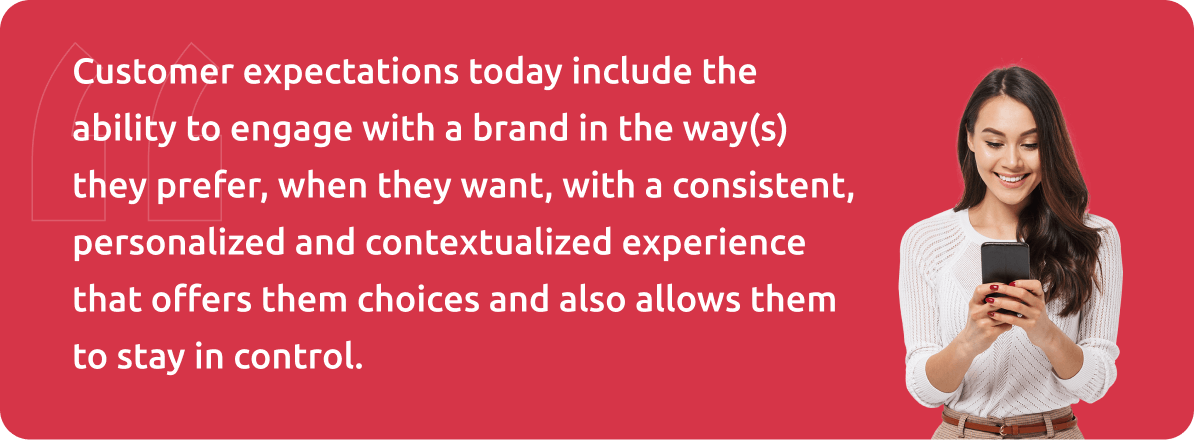8 ways to enhance your customer experience
When a customer engages with your company, whether it’s to obtain a service or buy a product or solution, one basic expectation underpins the engagement— receiving a great experience. From the customer’s point of view, a great experience can mean personalization, customized solutions/ services that address their pain points, responsiveness, attention to detail, timeliness and consistency, an omnichannel experience, good support, and so on. For the enterprise, offering that great customer experience means going above and beyond to deliver on your promise. This can lead to enhanced brand reputation, customer loyalty and advocacy, increased revenue, and so much more. That’s a win-win for all – but doesn’t always happen! Here are 8 questions to ask yourself why.
- Are your employees engaged and empowered?
- Are you being innovative?
- Are you optimizing the use of technology?
- What’s your mobile user experience design like?
- Are you offering them a seamless, omnichannel experience?
- Are you focusing on building relationships?
- Are you educating your customers?
- Are you taking customer feedback seriously?
Your employees are the ones who interact with customers, understand their needs, solve their problems, and – if they do this well – help build long-lasting relationships with customers. If employees are unempowered, disengaged, or simply lack the tools and training they need to do their jobs well, your customer experience will reflect this. Ensure that your employees receive the training, information, and empowerment they need to offer customers a smooth and rewarding experience every single time.
According to PwC’s Future of Customer Experience Survey 2017/18, speed, convenience, helpful employees and friendly service were the elements that matter most (over 70% in importance) to consumers, while one-third of people surveyed said a single bad experience with a brand they loved would be enough to make them walk away.
PwC’s Future of Customer Experience Survey 2017/18
Encourage your employees to come up with ideas for new ways to solve customer problems, and empower them to execute on these if they are convinced they will work. This sort of responsiveness meets customer expectations and builds trust and advocacy. The idea can be extrapolated to streamline your entire process, resulting in better cost-effectiveness and/or time and effort saved. Another way of being innovative is to be proactive about potential glitches or problems that might arise and being prepared to tackle them even before customers are affected.
Use technology well to achieve your goals. Advanced AI and machine learning tools and collaboration technology have ensured seamless connectivity, ability to solve problems in real time or sometimes before they occur, dissemination of information across your ecosystem, analytics capabilities that enable you to ascertain customer needs and reactions, industry trends, and much more. Make use of this wealth of tools and data to give your customers the best experience possible.
With ever-increasing numbers of people using their mobile devices to learn about and connect with a brand, it’s imperative that your mobile app experience is excellent. Some of the primary features people are looking for include easy navigation, rapid loading of the site, and good search functionality.

Omnichannel experiences are all about offering the customer exactly this experience.
For example, a customer with a problem might choose to first try a Conversational AI or Chatbot or email option, but also want to have the ability to switch to speaking directly with someone if their needs are not met by the former, and to not have to explain their problem all over again. Or, when a person is browsing in an e-commerce app on a mobile and decide to switch to the desktop version, they expect to continue from where they left off on mobile. The easier, smoother and more consistent the experience, the better.
Use technology as a means to an end – that of offering a great experience. But do not lose sight of the fact that the human touch still matters. Work on nurturing long-term relationships with your customers. Make the effort to understand their needs, values and expectations, and then be proactive about exceeding these.
Encourage your employees to be responsive and to follow up with customers when they need to. A good relationship with customers leads to benefits like customer loyalty and advocacy that will attract new customers, potential upsell and cross-sell opportunities, potential partnerships and more.
First, help educate them about the product or service they are purchasing from you, so that it proves a valuable investment for them. In the longer term, invest in opportunities to educate your customers, help them keep abreast of new trends that can potentially affect their industry verticals, and inform them of new updates you are making that can benefit them. In addition to inspiring trust and loyalty, you will be viewed as a trusted advisor. It also helps position you as a thought leader in the field, which will help differentiate you from your competitors.
How many times have you complained to a call center executive about something you are dissatisfied with, only to have them say “I will report this” or “I will mention this issue”, knowing nothing will come of it? And how would you feel if the executive gets back to you in a few days to explain what action has been taken to ensure you (or any customer) will never face this issue again?
Taking action based on feedback is an important part of offering an optimal customer experience. It makes the customer feel their voice is heard, and can be an important differentiator. It can also offer the added benefit of improving your processes and systems or of sparking ideas for new products or services.
At TATA COMMUNICATIONS DIGO, providing a delightful customer experience is a priority. After all, we’re in the business of connecting people and enterprises across the globe so they can collaborate and communicate with ease.
Contact us today to learn more.
Related Media
The changing digital communications landscape has created a need for cloud communications and platform-based customer engagement models
With an increasing fragmentation of communications channels, along with fragmentation in consumer preferences, organisations need to be able to find ways to communicate and engage with their customers across multiple forms of media.
TATA COMMUNICATIONS DIGO programmable voice communication
Organizations worldwide are adopting a cloud communications approach, also known as Communications Platform as a Service (CPaaS).
